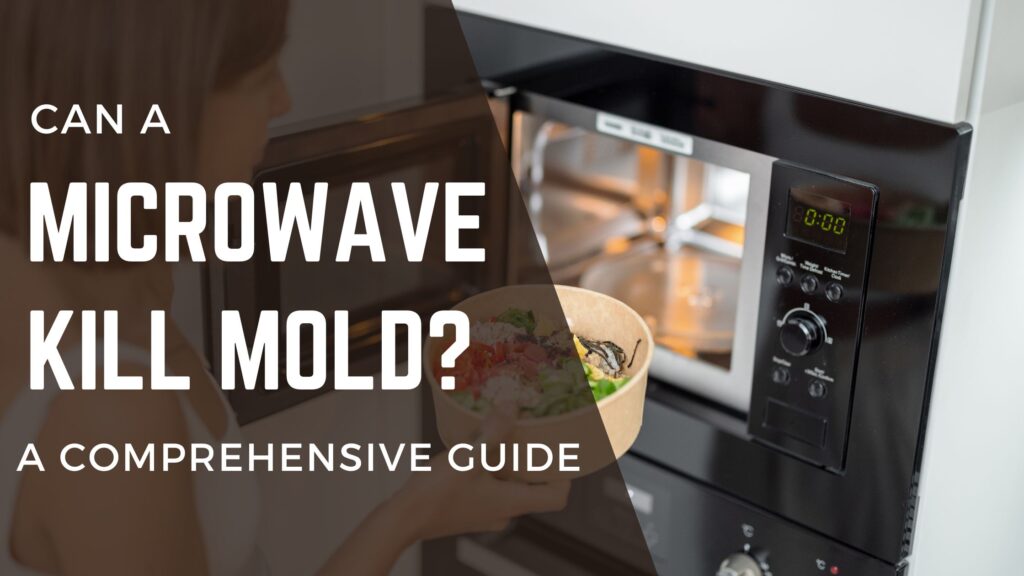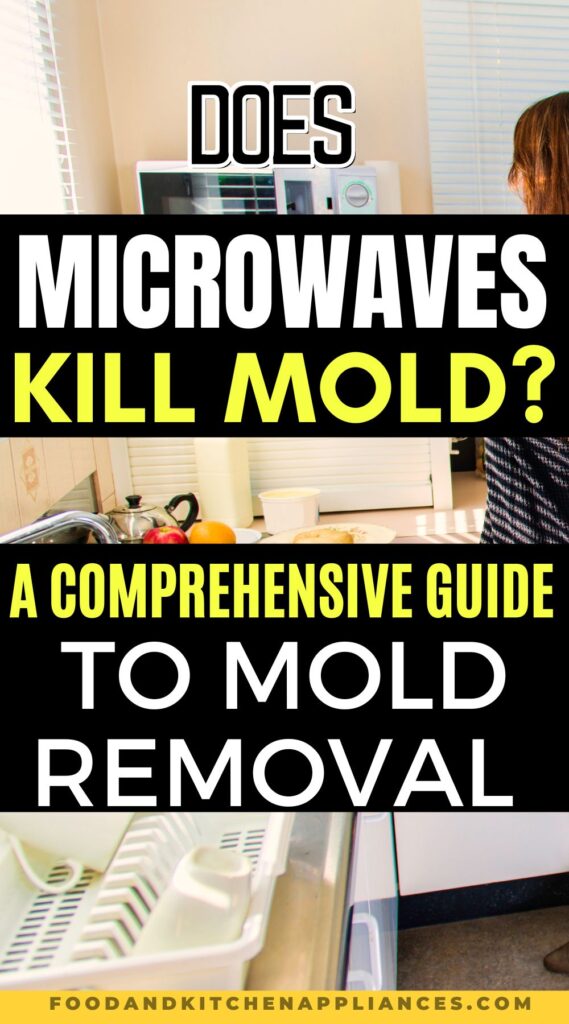If you’ve ever found mold growing in your home, you know how frustrating it can be to get rid of it. One common question in our minds is whether a microwave can kill mold.
The answer is yes – microwaving mold can kill it for a certain amount of time. Exposing mold to high heat can kill it and prevent it from spreading further. However, it’s important to note that not all types of mold can be killed with a microwave. Some types of mold are more resistant than others, so it’s essential to do your research before attempting to use this method.

Mold is a type of fungus that thrives in warm, damp environments. It can grow on various surfaces, including walls, floors, and even food. While there are many ways to get rid of mold, using a microwave is a quick and easy method many people swear by.
Microwave and Mold
What is mold?
Mold is a type of fungus that grows in damp and humid environments. It can grow on various surfaces, including food, walls, and furniture. Mold can cause health problems such as allergies, respiratory issues, and skin irritation.
Can a microwave kill mold?
Yes, a microwave can kill mold. Microwaving effectively kills mold on non-porous surfaces such as glass, plastic, and ceramic. However, microwaving may not be effective on porous surfaces such as wood, fabric, and paper.
To kill mold in a microwave, follow these steps:
- Clean the affected area with soap and water to remove any visible mold.
- Place the item in the microwave and set the timer for 5-10 seconds on high heat.
- Check the item for any remaining mold. If mold is still present, repeat the process until the mold is gone.
It is important to note that microwaving moldy food is not recommended. The heat from the microwave may not kill all the mold spores, and some may still be present in the food. It is best to discard moldy food to avoid any potential health risks.
Microwaving is an effective way to kill mold on non-porous surfaces but may not be effective on porous surfaces. It is important to take proper precautions to prevent mold growth in the first place, such as keeping your home dry and well-ventilated.
How to Use Microwaves to Kill Mold
Step 1: Prepare the moldy item
Before using the microwave to kill mold, you need to prepare the moldy item. Make sure to remove any visible mold growth and wipe the item with a damp cloth. Also, ensure that the item is microwave safe and won’t be damaged by the heat.
Step 2: Clean the microwave
Cleaning the microwave is crucial to ensure that there is no food or debris left that could interfere with the mold-killing process. Wipe the inside of the microwave with a damp cloth to remove any dirt or debris.
Step 3: Place the item in the microwave
Place the moldy item in the microwave’s center and ensure it is not touching the walls or ceiling of the microwave.
Step 4: Microwave the item
Microwave the item on high power for 5 minutes. If the item is large, you may need to microwave it for longer. The heat from the microwave will kill any remaining mold spores on the item.
Step 5: Remove the item from the microwave
Carefully remove the item from the microwave, as it may be hot. Allow it to cool before using or storing it.
Using the microwave to kill mold is a quick and easy way to eliminate mold on small items. However, it’s important to note that this method may not be adequate for large items or severe mold infestations. If you’re dealing with a more significant mold problem, it’s best to seek professional help.
Safety Precautions
When using a microwave to kill mold, taking certain safety precautions to protect yourself and others nearby is essential. Here are a few things you should keep in mind:
Wear Gloves and a Mask
Before handling moldy items or placing them in the microwave, wear gloves and a mask. This will help prevent you from inhaling mold spores or contacting them directly. You should also avoid touching your face or other body parts while handling moldy items.
Use a Microwave-Safe Container
When microwaving moldy items, it’s essential to use a container that is specifically labeled as microwave-safe. This will help prevent the container from melting or releasing harmful chemicals into your food or the air. You should also avoid using metal containers or utensils, which can cause sparks and damage your microwave.
Ventilate the Room After Microwaving
After microwaving moldy items, it’s a good idea to open windows or turn on a fan to help ventilate the room. This will help disperse any mold spores or odors that may have been released during the microwaving process. You should also avoid breathing in any air that may have come into contact with mold spores and dispose of any moldy items in a sealed plastic bag.
Following these safety precautions can help protect yourself and others while effectively killing mold using a microwave.
What are the dangers of microwaving moldy food?
Microwaving moldy food can be potentially dangerous due to several reasons:
1. Health risks
Mold is a type of fungus that can produce mycotoxins, which are toxic compounds. When you microwave moldy food, the heat from the microwave may not effectively destroy these mycotoxins, and they can remain in the food. Consuming mycotoxins can lead to various health problems, including allergic reactions, respiratory issues, gastrointestinal distress, and in severe cases, organ damage.
2. Incomplete removal of mold
Microwaving may not eliminate the mold from the food. Even if the heat kills some of the mold spores, others may survive, especially if the food has a high moisture content or if the mold has deeply penetrated the food.
This can increase the risk of ingesting live mold, further contaminating your digestive system and potentially causing illness.
3. Spread of mold spores
Microwaving moldy food can release mold spores into the air within the microwave. These spores can then spread to other surfaces, utensils, or food items present in the microwave, leading to cross-contamination.
Ingesting or inhaling these mold spores can increase the risk of respiratory issues, allergies, or infections.
4. Masking the signs of spoilage
Microwaving moldy food can temporarily mask the odor and appearance of spoilage.
Moldy food often develops an unpleasant smell and visible mold growth, which act as visible warnings of potential health hazards.
By microwaving the food, you may inadvertently make it appear and smell more acceptable, increasing the likelihood of consuming contaminated food.
To ensure food safety, discarding moldy food rather than attempting to salvage it by microwaving is generally recommended. If you notice mold on your food, it’s best to err on the side of caution and dispose of it properly to prevent any potential health risks.
Alternative Methods
If you prefer not to use a microwave to kill mold, you can try several other methods. Here are a few options:
Using vinegar
Vinegar is a natural disinfectant that can help kill mold. Here’s how to use it:
- Mix equal parts white vinegar and water in a spray bottle.
- Spray the solution onto the moldy surface.
- Let it sit for an hour.
- Wipe the surface clean with a damp cloth.
Note that vinegar may not be as effective as bleach or hydrogen peroxide, especially on porous surfaces.
Using bleach
Bleach is a strong disinfectant that can effectively kill mold. Here’s how to use it:
- Mix 1 cup of bleach with 1 gallon of water.
- Use a scrub brush to apply the solution to the moldy surface.
- Let it sit for 10 minutes.
- Rinse the surface clean with water.
Be sure to wear gloves and protective eyewear when using bleach, and avoid using it on porous surfaces or fabrics.
Using hydrogen peroxide
Hydrogen peroxide is another natural disinfectant that can help kill mold. Here’s how to use it:
- Mix equal parts hydrogen peroxide and water in a spray bottle.
- Spray the solution onto the moldy surface.
- Let it sit for 10 minutes.
- Wipe the surface clean with a damp cloth.
Hydrogen peroxide is a safer alternative to bleach but may not be as effective on tough mold stains.
Remember to test any cleaning solution on a small, inconspicuous area before using it on a larger surface. And always wear protective gear when handling mold and cleaning solutions.

Frequently Asked Questions
Is it safe to use a microwave with mold inside?
No, it is not safe to use a microwave with mold inside. Mold can release harmful toxins that can contaminate your food and cause health problems. It is important to clean your microwave regularly and avoid leaving any food or moisture inside.
How can I prevent mold from growing in my microwave?
To prevent mold from growing in your microwave, make sure to clean it regularly with mild detergent and warm water. Avoid leaving any food or moisture inside for extended periods. You can also leave the door open when the microwave is not in use to allow for ventilation and prevent moisture buildup.
What should I do if I find mold in my microwave vent?
If you find mold in your microwave vent, cleaning it thoroughly and removing any visible mold is important. You can use a vinegar and water solution or a commercial mold cleaner to clean the vent. Be sure to wear gloves and a mask to protect yourself from mold spores.
How do I safely clean mold from my microwave?
To safely clean mold from your microwave, unplug it and remove the turntable and any other removable parts. Then, mix a solution of vinegar and water and use a soft cloth to wipe down the interior of the microwave. Be sure to wear gloves and a mask to protect yourself from mold spores.
Can microwaving food kill mold?
No, microwaving food cannot kill mold. While microwaving can kill bacteria and viruses, it is ineffective against mold. If you find mold in your food, it is best to discard it and clean your microwave thoroughly.
Does vinegar effectively kill mold in a microwave?
Vinegar is an effective natural cleaner that can kill mold in a microwave. Mix equal parts of vinegar and water and use a soft cloth to wipe down the interior of the microwave. Be sure to wear gloves and a mask to protect yourself from mold spores.
How to defrost hot buns in a microwave?